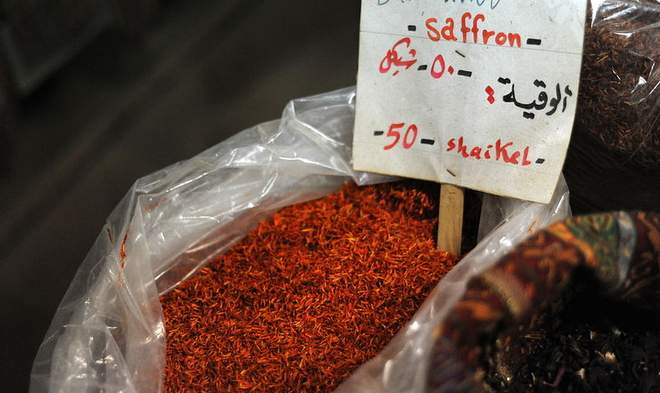Saffron has been traded and used for thousands of years, and has long been prized for its distinctive flavor, aroma, and color throughout the world. It comes from the crocus sativus flower, commonly known as the saffron crocus. It is well known for its use in cooking and for dyeing clothing. The crocus plant grows about eight to twelve inches high and can have up to four purple flowers. Saffron is actually the dried stigma (the part of the flower that receives pollen) and style (that connects the stigma to the plant) left intact. Each flower has three crimson-colored stigmas. Saffron is the world’s most expensive spice by weight; harvesting it is very laborious as each saffron thread must be carefully hand picked and then sun dried, which helps to develop its slightly bitter, hay-like aroma.
The unique flavor and aroma associated with saffron come from organic compounds called picrocrocin and safranal. It also contains a chemical compound called crocin, which is primarily responsible for the distinct yellow hue it gives food and clothing. Saffron threads are best stored in an airtight container since the color and flavor molecules can be harmed by light and heat. A little saffron goes a long way in cooking—just one or two threads can flavor a pot of rice. The threads are usually rehydrated in warm water to extract the flavor and color. Saffron is used as a flavoring base and coloring agent in many cuisines, including Greek, Spanish, and Indian cuisines. It is known for its use in savory dishes such as paella and risotto, as well as in ice cream and cakes.
The saffron crocus is native to Southwest Asia and Greece, where it was first cultivated. It does not grow wild; it is a likely descendant of the wild crocus cartwrightianus and was developed through the selective breeding of plants with longer stamens. It was depicted in Greek frescoes dating back more than 3,600 years. Cultivation first spread east to Iran, Kashmir, and China. It was later introduced by the Arabs to Spain in the 10th century, and, later, other parts of Europe and North America. It has historically been a staple in Iran and Kashmir, and as of 2008 Iran produced 90 percent of the world’s saffron. Because saffron is so expensive to produce, it is sometimes adulterated with other additives that have similar dyeing, aromatic, and flavor properties.
There are at least 90 documented illnesses for which saffron has been used in traditional medicine. For example, it has been used in Ayurvedic medicine to treat arthritis, asthma, infertility, and impotence. The ancient Egyptians used saffron to treat kidney problems, and it was used by the Persians to treat depression. Modern scientific studies of saffron’s medicinal effectiveness are limited, but there are some examples, both in mainstream and alternative medicine. According to the Alternative Medicine Review, a study looking at the use of saffron found it to be relatively effective as a mood modifier. The number of studies on saffron’s health benefits in mainstream medical science has slowly increased, helping to legitimize thousands of years of traditional medicinal uses. For example, according to the National Center for Biotechnology Information, a study was conducted indicating the potential of saffron as an antioxidant, and another study published by the Journal of Translational Medicine indicated potential effectiveness in the treatment of macular degeneration.
Recipe-Saffron Rice
Ingredients
· 2 cups uncooked long-grain rice
· 3/4 teaspoon crushed saffron threads
· 4 tablespoons butter
· 6 whole cardamom seeds
· 4 whole cloves
· 3 cinnamon sticks
· 1 onion, chopped
· 3 cups boiling vegetable broth
· 1 teaspoon salt
Directions
1. Cover rice with cold water and set aside to soak for 30 minutes.
2. Soak saffron threads in 2 tablespoons boiling water.
3. Melt butter in a large saucepan over medium heat; add cardamom seeds, cloves, and cinnamon sticks and fry two minutes, stirring occasionally. Stir in onion and sauté, stirring occasionally, until golden brown. Stir in the rice, reduce heat to low, and simmer for five minutes, stirring constantly.
4. Pour in the boiling broth and stir in the salt and saffron.
5. Cover and cook until rice is cooked and all liquid is absorbed, about 40 minutes.















